Higher Nationals Unit 4: Management and Operations Report
VerifiedAdded on 2022/12/27
|10
|3913
|69
Report
AI Summary
This report examines the core concepts of management and operations, focusing on the roles of leaders and managers within an organization. It explores the distinct characteristics and responsibilities of leaders and managers, highlighting their functions in organizational contexts and the importance of effective management practices. The report uses Unilever as a case study to illustrate these concepts. It delves into various leadership theories, including situational, system, and contingency theories, providing a comprehensive overview of different leadership styles and their applications. The report also discusses key approaches to operational management, emphasizing their significance in achieving business objectives. Furthermore, it identifies factors impacting operations management and decision-making processes. The report is intended to provide students with a comprehensive understanding of leadership and management principles.
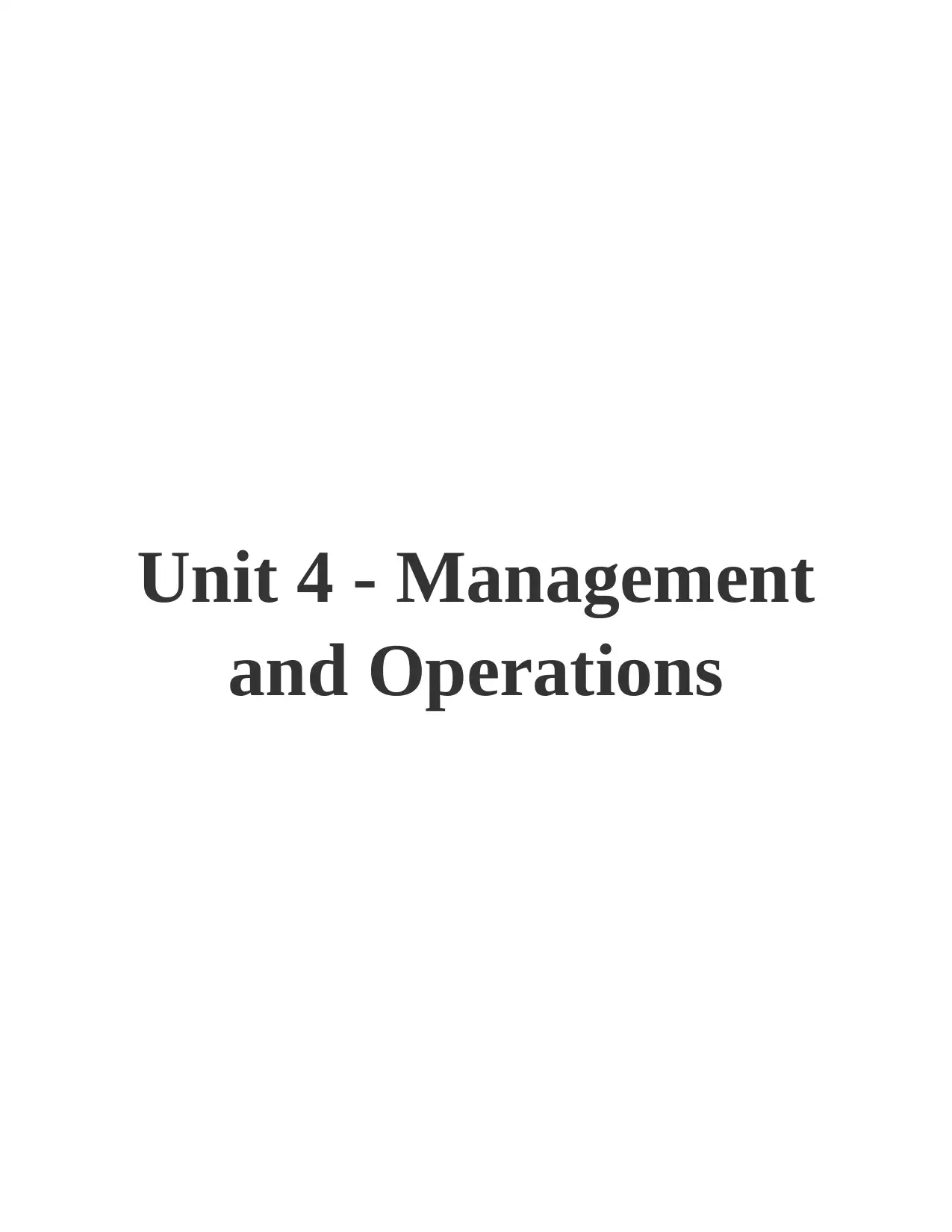
Unit 4 - Management
and Operations
and Operations
Paraphrase This Document
Need a fresh take? Get an instant paraphrase of this document with our AI Paraphraser
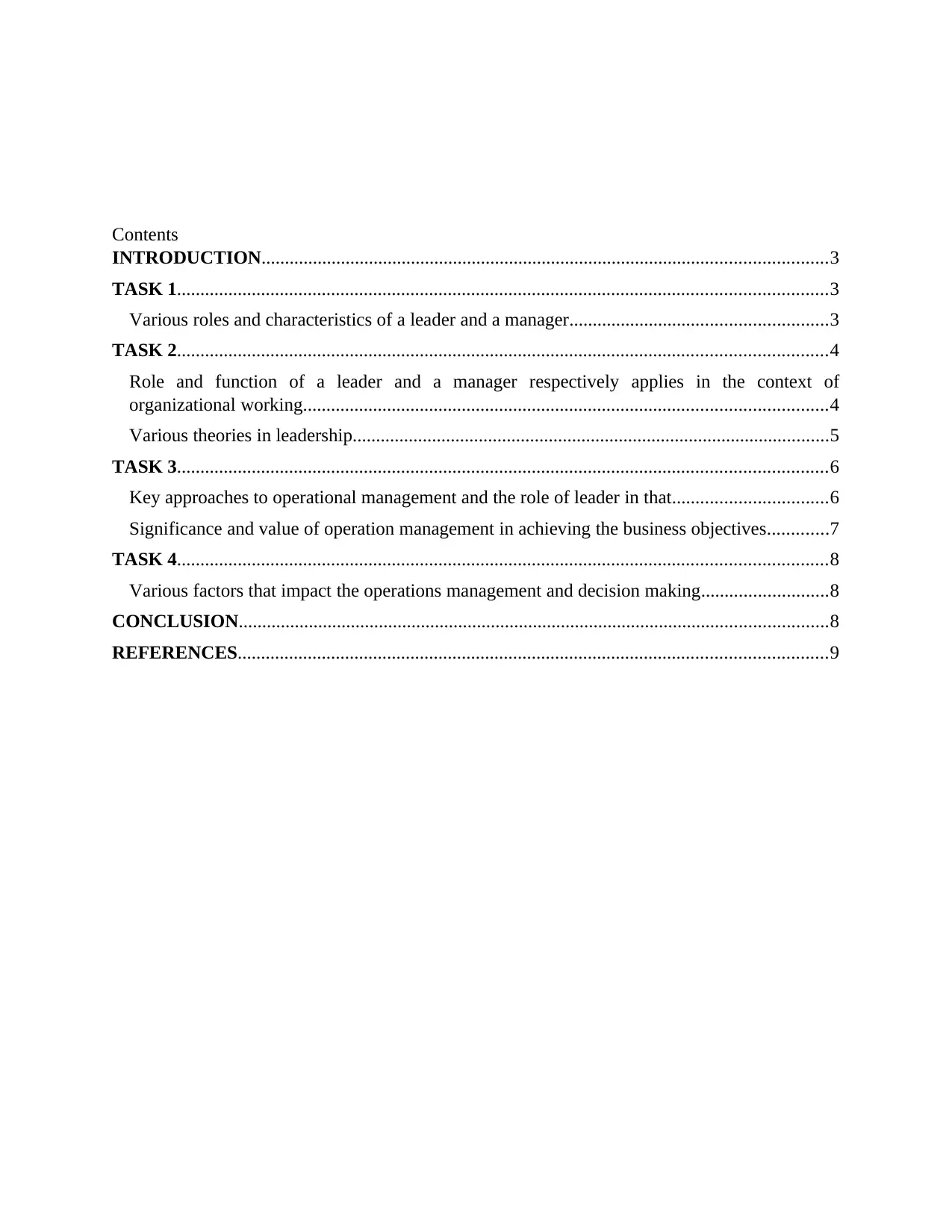
Contents
INTRODUCTION.........................................................................................................................3
TASK 1...........................................................................................................................................3
Various roles and characteristics of a leader and a manager.......................................................3
TASK 2...........................................................................................................................................4
Role and function of a leader and a manager respectively applies in the context of
organizational working................................................................................................................4
Various theories in leadership......................................................................................................5
TASK 3...........................................................................................................................................6
Key approaches to operational management and the role of leader in that.................................6
Significance and value of operation management in achieving the business objectives.............7
TASK 4...........................................................................................................................................8
Various factors that impact the operations management and decision making...........................8
CONCLUSION..............................................................................................................................8
REFERENCES..............................................................................................................................9
INTRODUCTION.........................................................................................................................3
TASK 1...........................................................................................................................................3
Various roles and characteristics of a leader and a manager.......................................................3
TASK 2...........................................................................................................................................4
Role and function of a leader and a manager respectively applies in the context of
organizational working................................................................................................................4
Various theories in leadership......................................................................................................5
TASK 3...........................................................................................................................................6
Key approaches to operational management and the role of leader in that.................................6
Significance and value of operation management in achieving the business objectives.............7
TASK 4...........................................................................................................................................8
Various factors that impact the operations management and decision making...........................8
CONCLUSION..............................................................................................................................8
REFERENCES..............................................................................................................................9
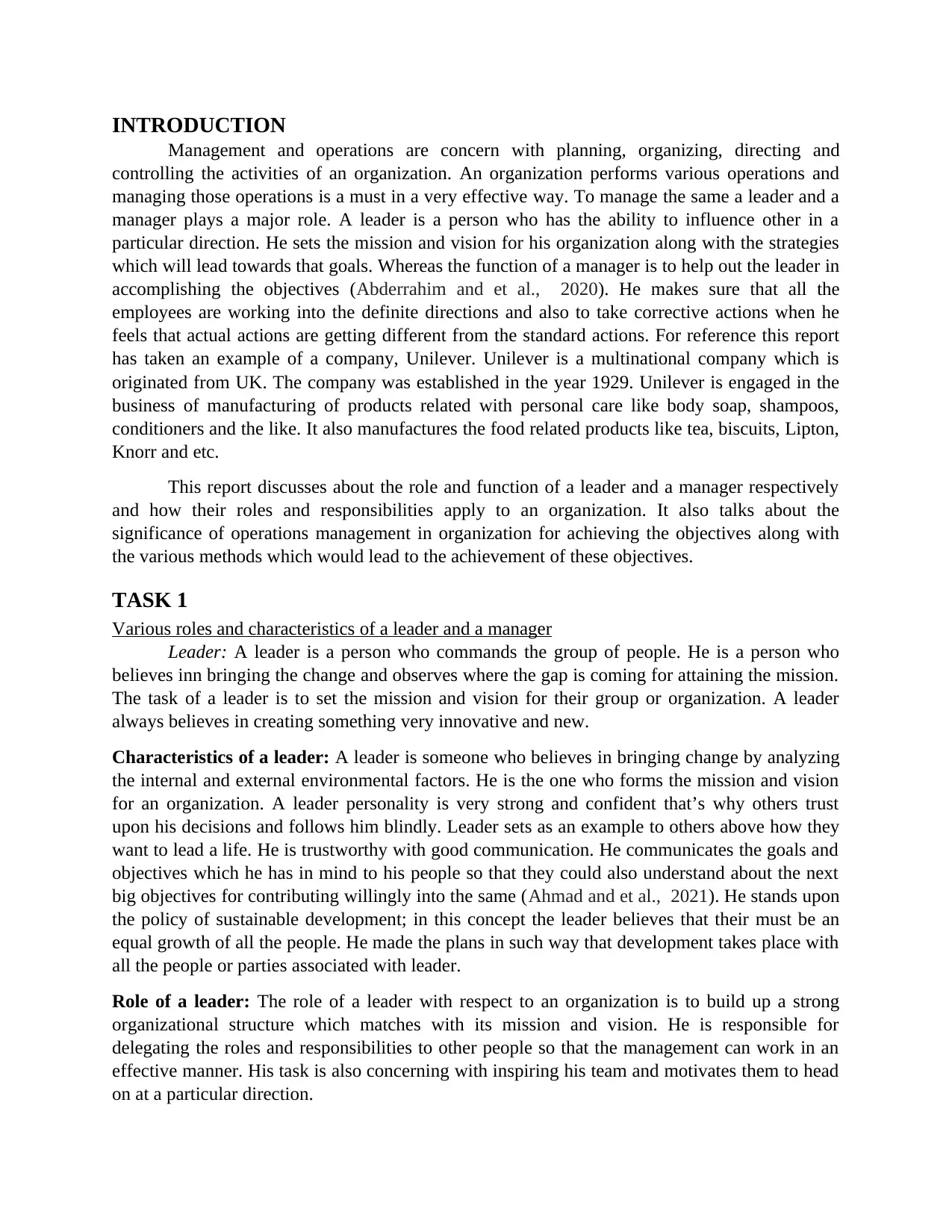
INTRODUCTION
Management and operations are concern with planning, organizing, directing and
controlling the activities of an organization. An organization performs various operations and
managing those operations is a must in a very effective way. To manage the same a leader and a
manager plays a major role. A leader is a person who has the ability to influence other in a
particular direction. He sets the mission and vision for his organization along with the strategies
which will lead towards that goals. Whereas the function of a manager is to help out the leader in
accomplishing the objectives (Abderrahim and et al., 2020). He makes sure that all the
employees are working into the definite directions and also to take corrective actions when he
feels that actual actions are getting different from the standard actions. For reference this report
has taken an example of a company, Unilever. Unilever is a multinational company which is
originated from UK. The company was established in the year 1929. Unilever is engaged in the
business of manufacturing of products related with personal care like body soap, shampoos,
conditioners and the like. It also manufactures the food related products like tea, biscuits, Lipton,
Knorr and etc.
This report discusses about the role and function of a leader and a manager respectively
and how their roles and responsibilities apply to an organization. It also talks about the
significance of operations management in organization for achieving the objectives along with
the various methods which would lead to the achievement of these objectives.
TASK 1
Various roles and characteristics of a leader and a manager
Leader: A leader is a person who commands the group of people. He is a person who
believes inn bringing the change and observes where the gap is coming for attaining the mission.
The task of a leader is to set the mission and vision for their group or organization. A leader
always believes in creating something very innovative and new.
Characteristics of a leader: A leader is someone who believes in bringing change by analyzing
the internal and external environmental factors. He is the one who forms the mission and vision
for an organization. A leader personality is very strong and confident that’s why others trust
upon his decisions and follows him blindly. Leader sets as an example to others above how they
want to lead a life. He is trustworthy with good communication. He communicates the goals and
objectives which he has in mind to his people so that they could also understand about the next
big objectives for contributing willingly into the same (Ahmad and et al., 2021). He stands upon
the policy of sustainable development; in this concept the leader believes that their must be an
equal growth of all the people. He made the plans in such way that development takes place with
all the people or parties associated with leader.
Role of a leader: The role of a leader with respect to an organization is to build up a strong
organizational structure which matches with its mission and vision. He is responsible for
delegating the roles and responsibilities to other people so that the management can work in an
effective manner. His task is also concerning with inspiring his team and motivates them to head
on at a particular direction.
Management and operations are concern with planning, organizing, directing and
controlling the activities of an organization. An organization performs various operations and
managing those operations is a must in a very effective way. To manage the same a leader and a
manager plays a major role. A leader is a person who has the ability to influence other in a
particular direction. He sets the mission and vision for his organization along with the strategies
which will lead towards that goals. Whereas the function of a manager is to help out the leader in
accomplishing the objectives (Abderrahim and et al., 2020). He makes sure that all the
employees are working into the definite directions and also to take corrective actions when he
feels that actual actions are getting different from the standard actions. For reference this report
has taken an example of a company, Unilever. Unilever is a multinational company which is
originated from UK. The company was established in the year 1929. Unilever is engaged in the
business of manufacturing of products related with personal care like body soap, shampoos,
conditioners and the like. It also manufactures the food related products like tea, biscuits, Lipton,
Knorr and etc.
This report discusses about the role and function of a leader and a manager respectively
and how their roles and responsibilities apply to an organization. It also talks about the
significance of operations management in organization for achieving the objectives along with
the various methods which would lead to the achievement of these objectives.
TASK 1
Various roles and characteristics of a leader and a manager
Leader: A leader is a person who commands the group of people. He is a person who
believes inn bringing the change and observes where the gap is coming for attaining the mission.
The task of a leader is to set the mission and vision for their group or organization. A leader
always believes in creating something very innovative and new.
Characteristics of a leader: A leader is someone who believes in bringing change by analyzing
the internal and external environmental factors. He is the one who forms the mission and vision
for an organization. A leader personality is very strong and confident that’s why others trust
upon his decisions and follows him blindly. Leader sets as an example to others above how they
want to lead a life. He is trustworthy with good communication. He communicates the goals and
objectives which he has in mind to his people so that they could also understand about the next
big objectives for contributing willingly into the same (Ahmad and et al., 2021). He stands upon
the policy of sustainable development; in this concept the leader believes that their must be an
equal growth of all the people. He made the plans in such way that development takes place with
all the people or parties associated with leader.
Role of a leader: The role of a leader with respect to an organization is to build up a strong
organizational structure which matches with its mission and vision. He is responsible for
delegating the roles and responsibilities to other people so that the management can work in an
effective manner. His task is also concerning with inspiring his team and motivates them to head
on at a particular direction.
⊘ This is a preview!⊘
Do you want full access?
Subscribe today to unlock all pages.

Trusted by 1+ million students worldwide
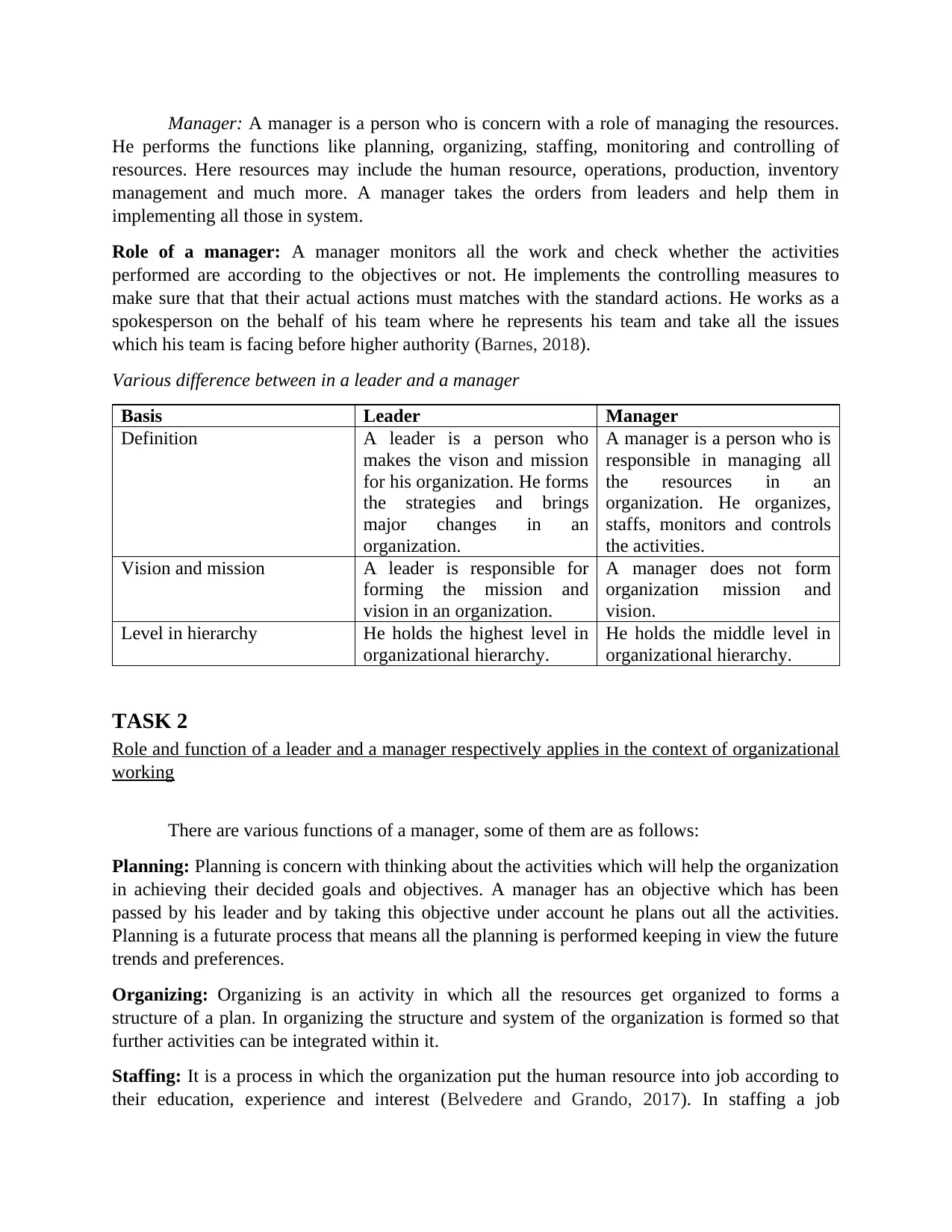
Manager: A manager is a person who is concern with a role of managing the resources.
He performs the functions like planning, organizing, staffing, monitoring and controlling of
resources. Here resources may include the human resource, operations, production, inventory
management and much more. A manager takes the orders from leaders and help them in
implementing all those in system.
Role of a manager: A manager monitors all the work and check whether the activities
performed are according to the objectives or not. He implements the controlling measures to
make sure that that their actual actions must matches with the standard actions. He works as a
spokesperson on the behalf of his team where he represents his team and take all the issues
which his team is facing before higher authority (Barnes, 2018).
Various difference between in a leader and a manager
Basis Leader Manager
Definition A leader is a person who
makes the vison and mission
for his organization. He forms
the strategies and brings
major changes in an
organization.
A manager is a person who is
responsible in managing all
the resources in an
organization. He organizes,
staffs, monitors and controls
the activities.
Vision and mission A leader is responsible for
forming the mission and
vision in an organization.
A manager does not form
organization mission and
vision.
Level in hierarchy He holds the highest level in
organizational hierarchy.
He holds the middle level in
organizational hierarchy.
TASK 2
Role and function of a leader and a manager respectively applies in the context of organizational
working
There are various functions of a manager, some of them are as follows:
Planning: Planning is concern with thinking about the activities which will help the organization
in achieving their decided goals and objectives. A manager has an objective which has been
passed by his leader and by taking this objective under account he plans out all the activities.
Planning is a futurate process that means all the planning is performed keeping in view the future
trends and preferences.
Organizing: Organizing is an activity in which all the resources get organized to forms a
structure of a plan. In organizing the structure and system of the organization is formed so that
further activities can be integrated within it.
Staffing: It is a process in which the organization put the human resource into job according to
their education, experience and interest (Belvedere and Grando, 2017). In staffing a job
He performs the functions like planning, organizing, staffing, monitoring and controlling of
resources. Here resources may include the human resource, operations, production, inventory
management and much more. A manager takes the orders from leaders and help them in
implementing all those in system.
Role of a manager: A manager monitors all the work and check whether the activities
performed are according to the objectives or not. He implements the controlling measures to
make sure that that their actual actions must matches with the standard actions. He works as a
spokesperson on the behalf of his team where he represents his team and take all the issues
which his team is facing before higher authority (Barnes, 2018).
Various difference between in a leader and a manager
Basis Leader Manager
Definition A leader is a person who
makes the vison and mission
for his organization. He forms
the strategies and brings
major changes in an
organization.
A manager is a person who is
responsible in managing all
the resources in an
organization. He organizes,
staffs, monitors and controls
the activities.
Vision and mission A leader is responsible for
forming the mission and
vision in an organization.
A manager does not form
organization mission and
vision.
Level in hierarchy He holds the highest level in
organizational hierarchy.
He holds the middle level in
organizational hierarchy.
TASK 2
Role and function of a leader and a manager respectively applies in the context of organizational
working
There are various functions of a manager, some of them are as follows:
Planning: Planning is concern with thinking about the activities which will help the organization
in achieving their decided goals and objectives. A manager has an objective which has been
passed by his leader and by taking this objective under account he plans out all the activities.
Planning is a futurate process that means all the planning is performed keeping in view the future
trends and preferences.
Organizing: Organizing is an activity in which all the resources get organized to forms a
structure of a plan. In organizing the structure and system of the organization is formed so that
further activities can be integrated within it.
Staffing: It is a process in which the organization put the human resource into job according to
their education, experience and interest (Belvedere and Grando, 2017). In staffing a job
Paraphrase This Document
Need a fresh take? Get an instant paraphrase of this document with our AI Paraphraser
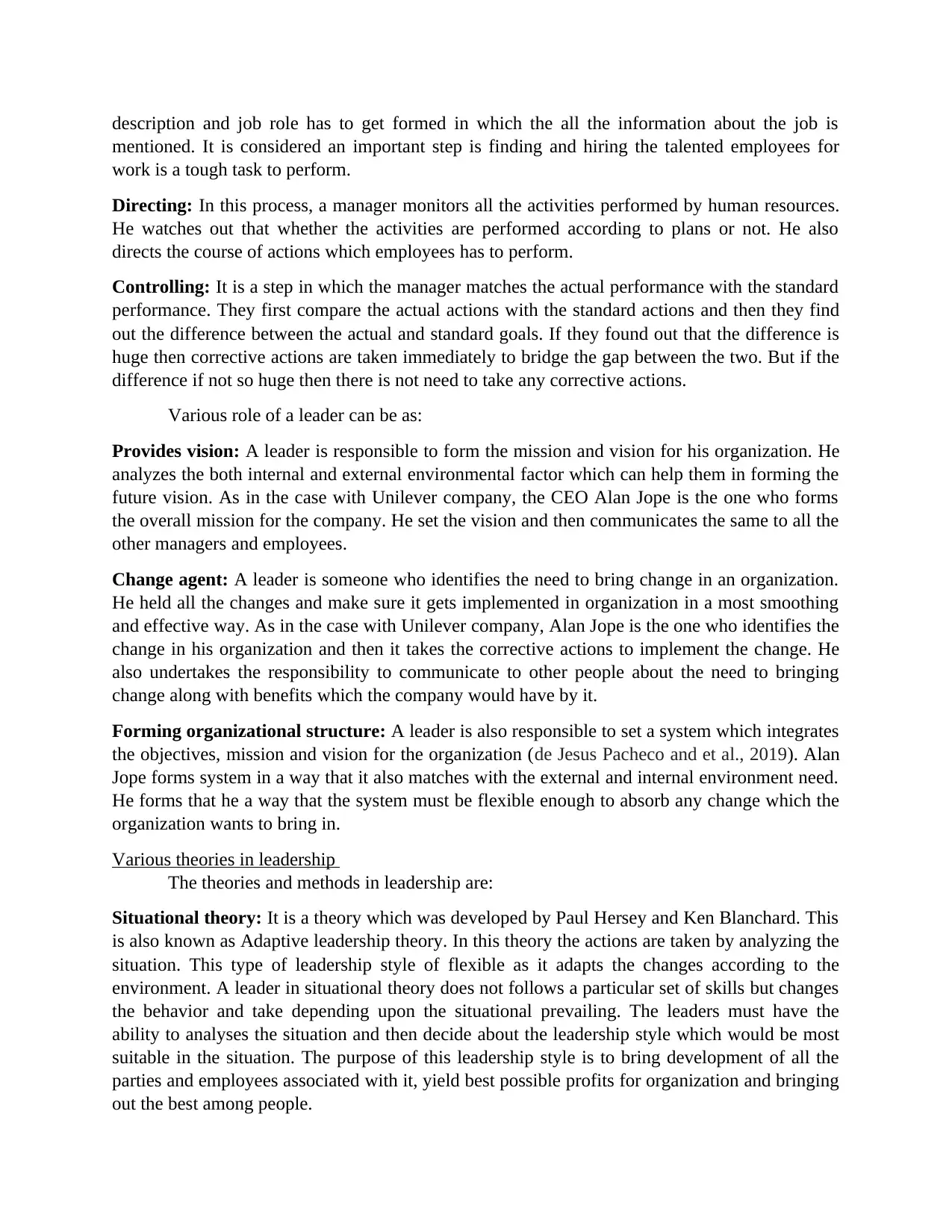
description and job role has to get formed in which the all the information about the job is
mentioned. It is considered an important step is finding and hiring the talented employees for
work is a tough task to perform.
Directing: In this process, a manager monitors all the activities performed by human resources.
He watches out that whether the activities are performed according to plans or not. He also
directs the course of actions which employees has to perform.
Controlling: It is a step in which the manager matches the actual performance with the standard
performance. They first compare the actual actions with the standard actions and then they find
out the difference between the actual and standard goals. If they found out that the difference is
huge then corrective actions are taken immediately to bridge the gap between the two. But if the
difference if not so huge then there is not need to take any corrective actions.
Various role of a leader can be as:
Provides vision: A leader is responsible to form the mission and vision for his organization. He
analyzes the both internal and external environmental factor which can help them in forming the
future vision. As in the case with Unilever company, the CEO Alan Jope is the one who forms
the overall mission for the company. He set the vision and then communicates the same to all the
other managers and employees.
Change agent: A leader is someone who identifies the need to bring change in an organization.
He held all the changes and make sure it gets implemented in organization in a most smoothing
and effective way. As in the case with Unilever company, Alan Jope is the one who identifies the
change in his organization and then it takes the corrective actions to implement the change. He
also undertakes the responsibility to communicate to other people about the need to bringing
change along with benefits which the company would have by it.
Forming organizational structure: A leader is also responsible to set a system which integrates
the objectives, mission and vision for the organization (de Jesus Pacheco and et al., 2019). Alan
Jope forms system in a way that it also matches with the external and internal environment need.
He forms that he a way that the system must be flexible enough to absorb any change which the
organization wants to bring in.
Various theories in leadership
The theories and methods in leadership are:
Situational theory: It is a theory which was developed by Paul Hersey and Ken Blanchard. This
is also known as Adaptive leadership theory. In this theory the actions are taken by analyzing the
situation. This type of leadership style of flexible as it adapts the changes according to the
environment. A leader in situational theory does not follows a particular set of skills but changes
the behavior and take depending upon the situational prevailing. The leaders must have the
ability to analyses the situation and then decide about the leadership style which would be most
suitable in the situation. The purpose of this leadership style is to bring development of all the
parties and employees associated with it, yield best possible profits for organization and bringing
out the best among people.
mentioned. It is considered an important step is finding and hiring the talented employees for
work is a tough task to perform.
Directing: In this process, a manager monitors all the activities performed by human resources.
He watches out that whether the activities are performed according to plans or not. He also
directs the course of actions which employees has to perform.
Controlling: It is a step in which the manager matches the actual performance with the standard
performance. They first compare the actual actions with the standard actions and then they find
out the difference between the actual and standard goals. If they found out that the difference is
huge then corrective actions are taken immediately to bridge the gap between the two. But if the
difference if not so huge then there is not need to take any corrective actions.
Various role of a leader can be as:
Provides vision: A leader is responsible to form the mission and vision for his organization. He
analyzes the both internal and external environmental factor which can help them in forming the
future vision. As in the case with Unilever company, the CEO Alan Jope is the one who forms
the overall mission for the company. He set the vision and then communicates the same to all the
other managers and employees.
Change agent: A leader is someone who identifies the need to bring change in an organization.
He held all the changes and make sure it gets implemented in organization in a most smoothing
and effective way. As in the case with Unilever company, Alan Jope is the one who identifies the
change in his organization and then it takes the corrective actions to implement the change. He
also undertakes the responsibility to communicate to other people about the need to bringing
change along with benefits which the company would have by it.
Forming organizational structure: A leader is also responsible to set a system which integrates
the objectives, mission and vision for the organization (de Jesus Pacheco and et al., 2019). Alan
Jope forms system in a way that it also matches with the external and internal environment need.
He forms that he a way that the system must be flexible enough to absorb any change which the
organization wants to bring in.
Various theories in leadership
The theories and methods in leadership are:
Situational theory: It is a theory which was developed by Paul Hersey and Ken Blanchard. This
is also known as Adaptive leadership theory. In this theory the actions are taken by analyzing the
situation. This type of leadership style of flexible as it adapts the changes according to the
environment. A leader in situational theory does not follows a particular set of skills but changes
the behavior and take depending upon the situational prevailing. The leaders must have the
ability to analyses the situation and then decide about the leadership style which would be most
suitable in the situation. The purpose of this leadership style is to bring development of all the
parties and employees associated with it, yield best possible profits for organization and bringing
out the best among people.
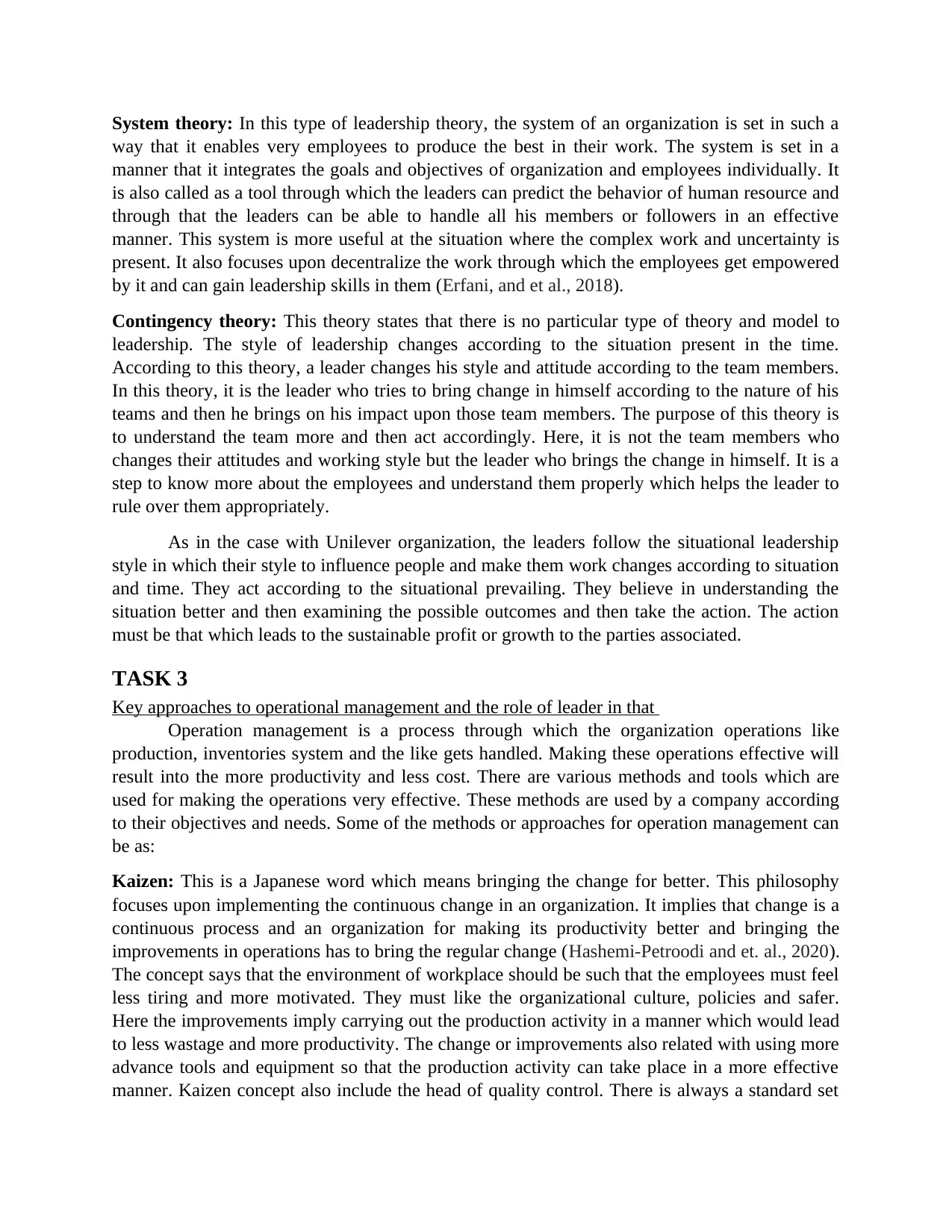
System theory: In this type of leadership theory, the system of an organization is set in such a
way that it enables very employees to produce the best in their work. The system is set in a
manner that it integrates the goals and objectives of organization and employees individually. It
is also called as a tool through which the leaders can predict the behavior of human resource and
through that the leaders can be able to handle all his members or followers in an effective
manner. This system is more useful at the situation where the complex work and uncertainty is
present. It also focuses upon decentralize the work through which the employees get empowered
by it and can gain leadership skills in them (Erfani, and et al., 2018).
Contingency theory: This theory states that there is no particular type of theory and model to
leadership. The style of leadership changes according to the situation present in the time.
According to this theory, a leader changes his style and attitude according to the team members.
In this theory, it is the leader who tries to bring change in himself according to the nature of his
teams and then he brings on his impact upon those team members. The purpose of this theory is
to understand the team more and then act accordingly. Here, it is not the team members who
changes their attitudes and working style but the leader who brings the change in himself. It is a
step to know more about the employees and understand them properly which helps the leader to
rule over them appropriately.
As in the case with Unilever organization, the leaders follow the situational leadership
style in which their style to influence people and make them work changes according to situation
and time. They act according to the situational prevailing. They believe in understanding the
situation better and then examining the possible outcomes and then take the action. The action
must be that which leads to the sustainable profit or growth to the parties associated.
TASK 3
Key approaches to operational management and the role of leader in that
Operation management is a process through which the organization operations like
production, inventories system and the like gets handled. Making these operations effective will
result into the more productivity and less cost. There are various methods and tools which are
used for making the operations very effective. These methods are used by a company according
to their objectives and needs. Some of the methods or approaches for operation management can
be as:
Kaizen: This is a Japanese word which means bringing the change for better. This philosophy
focuses upon implementing the continuous change in an organization. It implies that change is a
continuous process and an organization for making its productivity better and bringing the
improvements in operations has to bring the regular change (Hashemi-Petroodi and et. al., 2020).
The concept says that the environment of workplace should be such that the employees must feel
less tiring and more motivated. They must like the organizational culture, policies and safer.
Here the improvements imply carrying out the production activity in a manner which would lead
to less wastage and more productivity. The change or improvements also related with using more
advance tools and equipment so that the production activity can take place in a more effective
manner. Kaizen concept also include the head of quality control. There is always a standard set
way that it enables very employees to produce the best in their work. The system is set in a
manner that it integrates the goals and objectives of organization and employees individually. It
is also called as a tool through which the leaders can predict the behavior of human resource and
through that the leaders can be able to handle all his members or followers in an effective
manner. This system is more useful at the situation where the complex work and uncertainty is
present. It also focuses upon decentralize the work through which the employees get empowered
by it and can gain leadership skills in them (Erfani, and et al., 2018).
Contingency theory: This theory states that there is no particular type of theory and model to
leadership. The style of leadership changes according to the situation present in the time.
According to this theory, a leader changes his style and attitude according to the team members.
In this theory, it is the leader who tries to bring change in himself according to the nature of his
teams and then he brings on his impact upon those team members. The purpose of this theory is
to understand the team more and then act accordingly. Here, it is not the team members who
changes their attitudes and working style but the leader who brings the change in himself. It is a
step to know more about the employees and understand them properly which helps the leader to
rule over them appropriately.
As in the case with Unilever organization, the leaders follow the situational leadership
style in which their style to influence people and make them work changes according to situation
and time. They act according to the situational prevailing. They believe in understanding the
situation better and then examining the possible outcomes and then take the action. The action
must be that which leads to the sustainable profit or growth to the parties associated.
TASK 3
Key approaches to operational management and the role of leader in that
Operation management is a process through which the organization operations like
production, inventories system and the like gets handled. Making these operations effective will
result into the more productivity and less cost. There are various methods and tools which are
used for making the operations very effective. These methods are used by a company according
to their objectives and needs. Some of the methods or approaches for operation management can
be as:
Kaizen: This is a Japanese word which means bringing the change for better. This philosophy
focuses upon implementing the continuous change in an organization. It implies that change is a
continuous process and an organization for making its productivity better and bringing the
improvements in operations has to bring the regular change (Hashemi-Petroodi and et. al., 2020).
The concept says that the environment of workplace should be such that the employees must feel
less tiring and more motivated. They must like the organizational culture, policies and safer.
Here the improvements imply carrying out the production activity in a manner which would lead
to less wastage and more productivity. The change or improvements also related with using more
advance tools and equipment so that the production activity can take place in a more effective
manner. Kaizen concept also include the head of quality control. There is always a standard set
⊘ This is a preview!⊘
Do you want full access?
Subscribe today to unlock all pages.

Trusted by 1+ million students worldwide
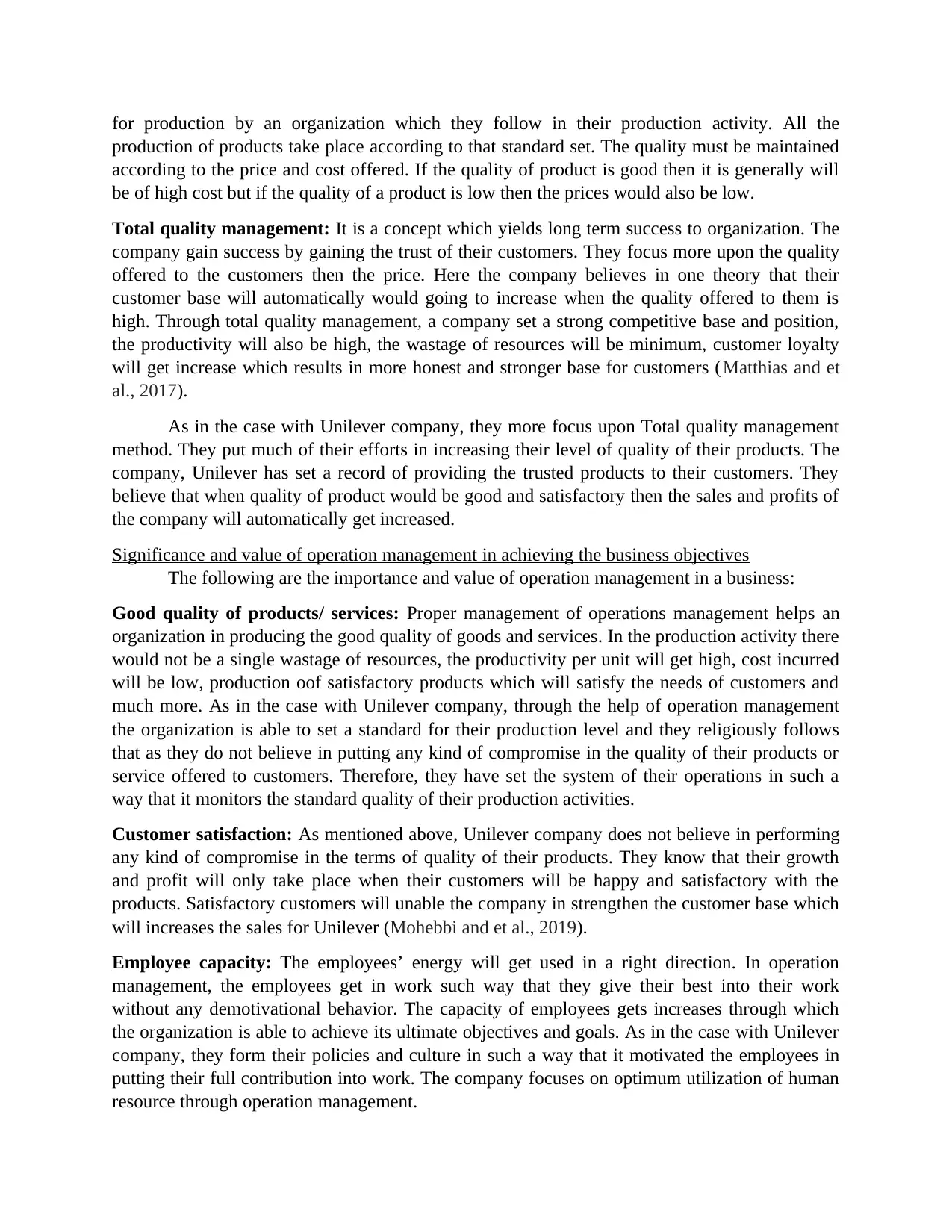
for production by an organization which they follow in their production activity. All the
production of products take place according to that standard set. The quality must be maintained
according to the price and cost offered. If the quality of product is good then it is generally will
be of high cost but if the quality of a product is low then the prices would also be low.
Total quality management: It is a concept which yields long term success to organization. The
company gain success by gaining the trust of their customers. They focus more upon the quality
offered to the customers then the price. Here the company believes in one theory that their
customer base will automatically would going to increase when the quality offered to them is
high. Through total quality management, a company set a strong competitive base and position,
the productivity will also be high, the wastage of resources will be minimum, customer loyalty
will get increase which results in more honest and stronger base for customers (Matthias and et
al., 2017).
As in the case with Unilever company, they more focus upon Total quality management
method. They put much of their efforts in increasing their level of quality of their products. The
company, Unilever has set a record of providing the trusted products to their customers. They
believe that when quality of product would be good and satisfactory then the sales and profits of
the company will automatically get increased.
Significance and value of operation management in achieving the business objectives
The following are the importance and value of operation management in a business:
Good quality of products/ services: Proper management of operations management helps an
organization in producing the good quality of goods and services. In the production activity there
would not be a single wastage of resources, the productivity per unit will get high, cost incurred
will be low, production oof satisfactory products which will satisfy the needs of customers and
much more. As in the case with Unilever company, through the help of operation management
the organization is able to set a standard for their production level and they religiously follows
that as they do not believe in putting any kind of compromise in the quality of their products or
service offered to customers. Therefore, they have set the system of their operations in such a
way that it monitors the standard quality of their production activities.
Customer satisfaction: As mentioned above, Unilever company does not believe in performing
any kind of compromise in the terms of quality of their products. They know that their growth
and profit will only take place when their customers will be happy and satisfactory with the
products. Satisfactory customers will unable the company in strengthen the customer base which
will increases the sales for Unilever (Mohebbi and et al., 2019).
Employee capacity: The employees’ energy will get used in a right direction. In operation
management, the employees get in work such way that they give their best into their work
without any demotivational behavior. The capacity of employees gets increases through which
the organization is able to achieve its ultimate objectives and goals. As in the case with Unilever
company, they form their policies and culture in such a way that it motivated the employees in
putting their full contribution into work. The company focuses on optimum utilization of human
resource through operation management.
production of products take place according to that standard set. The quality must be maintained
according to the price and cost offered. If the quality of product is good then it is generally will
be of high cost but if the quality of a product is low then the prices would also be low.
Total quality management: It is a concept which yields long term success to organization. The
company gain success by gaining the trust of their customers. They focus more upon the quality
offered to the customers then the price. Here the company believes in one theory that their
customer base will automatically would going to increase when the quality offered to them is
high. Through total quality management, a company set a strong competitive base and position,
the productivity will also be high, the wastage of resources will be minimum, customer loyalty
will get increase which results in more honest and stronger base for customers (Matthias and et
al., 2017).
As in the case with Unilever company, they more focus upon Total quality management
method. They put much of their efforts in increasing their level of quality of their products. The
company, Unilever has set a record of providing the trusted products to their customers. They
believe that when quality of product would be good and satisfactory then the sales and profits of
the company will automatically get increased.
Significance and value of operation management in achieving the business objectives
The following are the importance and value of operation management in a business:
Good quality of products/ services: Proper management of operations management helps an
organization in producing the good quality of goods and services. In the production activity there
would not be a single wastage of resources, the productivity per unit will get high, cost incurred
will be low, production oof satisfactory products which will satisfy the needs of customers and
much more. As in the case with Unilever company, through the help of operation management
the organization is able to set a standard for their production level and they religiously follows
that as they do not believe in putting any kind of compromise in the quality of their products or
service offered to customers. Therefore, they have set the system of their operations in such a
way that it monitors the standard quality of their production activities.
Customer satisfaction: As mentioned above, Unilever company does not believe in performing
any kind of compromise in the terms of quality of their products. They know that their growth
and profit will only take place when their customers will be happy and satisfactory with the
products. Satisfactory customers will unable the company in strengthen the customer base which
will increases the sales for Unilever (Mohebbi and et al., 2019).
Employee capacity: The employees’ energy will get used in a right direction. In operation
management, the employees get in work such way that they give their best into their work
without any demotivational behavior. The capacity of employees gets increases through which
the organization is able to achieve its ultimate objectives and goals. As in the case with Unilever
company, they form their policies and culture in such a way that it motivated the employees in
putting their full contribution into work. The company focuses on optimum utilization of human
resource through operation management.
Paraphrase This Document
Need a fresh take? Get an instant paraphrase of this document with our AI Paraphraser
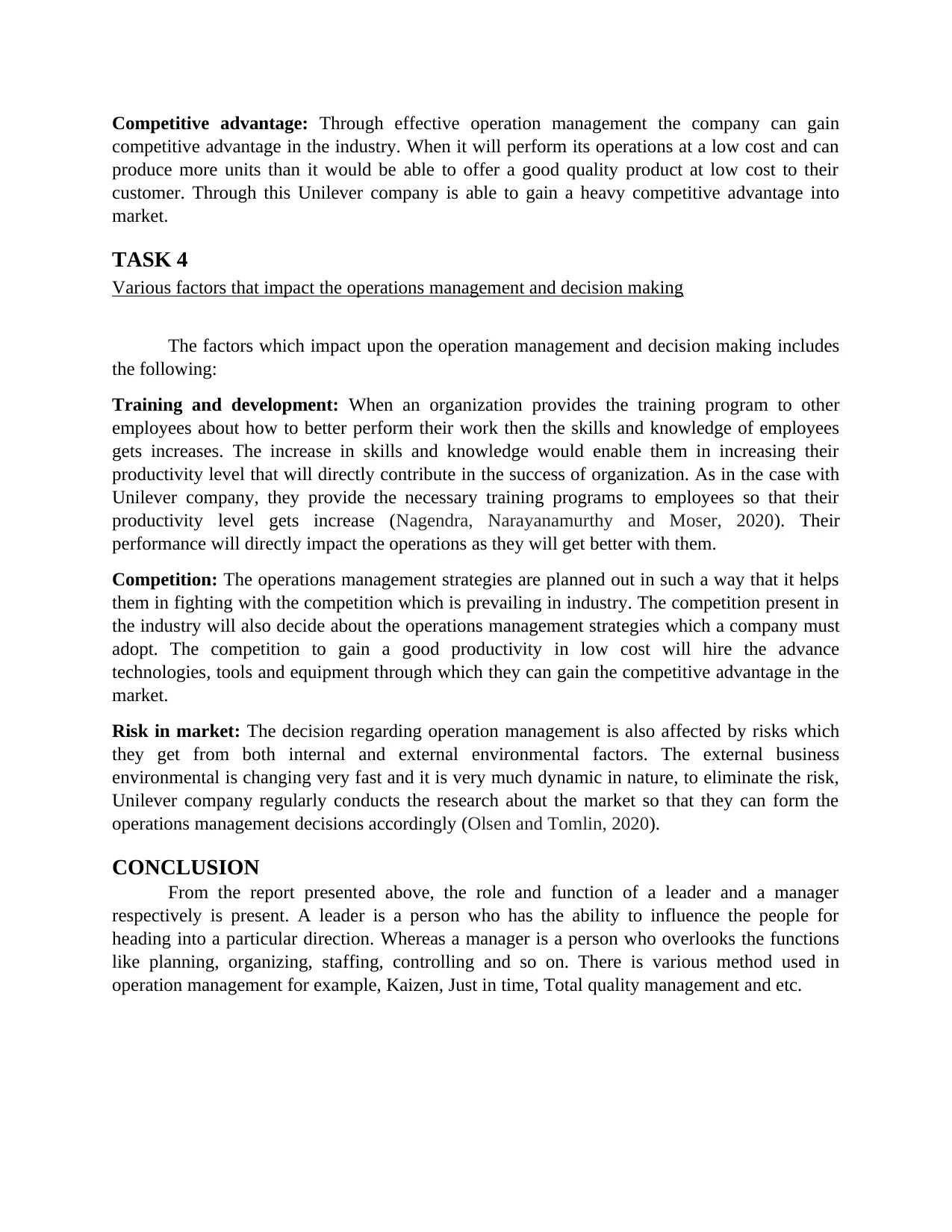
Competitive advantage: Through effective operation management the company can gain
competitive advantage in the industry. When it will perform its operations at a low cost and can
produce more units than it would be able to offer a good quality product at low cost to their
customer. Through this Unilever company is able to gain a heavy competitive advantage into
market.
TASK 4
Various factors that impact the operations management and decision making
The factors which impact upon the operation management and decision making includes
the following:
Training and development: When an organization provides the training program to other
employees about how to better perform their work then the skills and knowledge of employees
gets increases. The increase in skills and knowledge would enable them in increasing their
productivity level that will directly contribute in the success of organization. As in the case with
Unilever company, they provide the necessary training programs to employees so that their
productivity level gets increase (Nagendra, Narayanamurthy and Moser, 2020). Their
performance will directly impact the operations as they will get better with them.
Competition: The operations management strategies are planned out in such a way that it helps
them in fighting with the competition which is prevailing in industry. The competition present in
the industry will also decide about the operations management strategies which a company must
adopt. The competition to gain a good productivity in low cost will hire the advance
technologies, tools and equipment through which they can gain the competitive advantage in the
market.
Risk in market: The decision regarding operation management is also affected by risks which
they get from both internal and external environmental factors. The external business
environmental is changing very fast and it is very much dynamic in nature, to eliminate the risk,
Unilever company regularly conducts the research about the market so that they can form the
operations management decisions accordingly (Olsen and Tomlin, 2020).
CONCLUSION
From the report presented above, the role and function of a leader and a manager
respectively is present. A leader is a person who has the ability to influence the people for
heading into a particular direction. Whereas a manager is a person who overlooks the functions
like planning, organizing, staffing, controlling and so on. There is various method used in
operation management for example, Kaizen, Just in time, Total quality management and etc.
competitive advantage in the industry. When it will perform its operations at a low cost and can
produce more units than it would be able to offer a good quality product at low cost to their
customer. Through this Unilever company is able to gain a heavy competitive advantage into
market.
TASK 4
Various factors that impact the operations management and decision making
The factors which impact upon the operation management and decision making includes
the following:
Training and development: When an organization provides the training program to other
employees about how to better perform their work then the skills and knowledge of employees
gets increases. The increase in skills and knowledge would enable them in increasing their
productivity level that will directly contribute in the success of organization. As in the case with
Unilever company, they provide the necessary training programs to employees so that their
productivity level gets increase (Nagendra, Narayanamurthy and Moser, 2020). Their
performance will directly impact the operations as they will get better with them.
Competition: The operations management strategies are planned out in such a way that it helps
them in fighting with the competition which is prevailing in industry. The competition present in
the industry will also decide about the operations management strategies which a company must
adopt. The competition to gain a good productivity in low cost will hire the advance
technologies, tools and equipment through which they can gain the competitive advantage in the
market.
Risk in market: The decision regarding operation management is also affected by risks which
they get from both internal and external environmental factors. The external business
environmental is changing very fast and it is very much dynamic in nature, to eliminate the risk,
Unilever company regularly conducts the research about the market so that they can form the
operations management decisions accordingly (Olsen and Tomlin, 2020).
CONCLUSION
From the report presented above, the role and function of a leader and a manager
respectively is present. A leader is a person who has the ability to influence the people for
heading into a particular direction. Whereas a manager is a person who overlooks the functions
like planning, organizing, staffing, controlling and so on. There is various method used in
operation management for example, Kaizen, Just in time, Total quality management and etc.
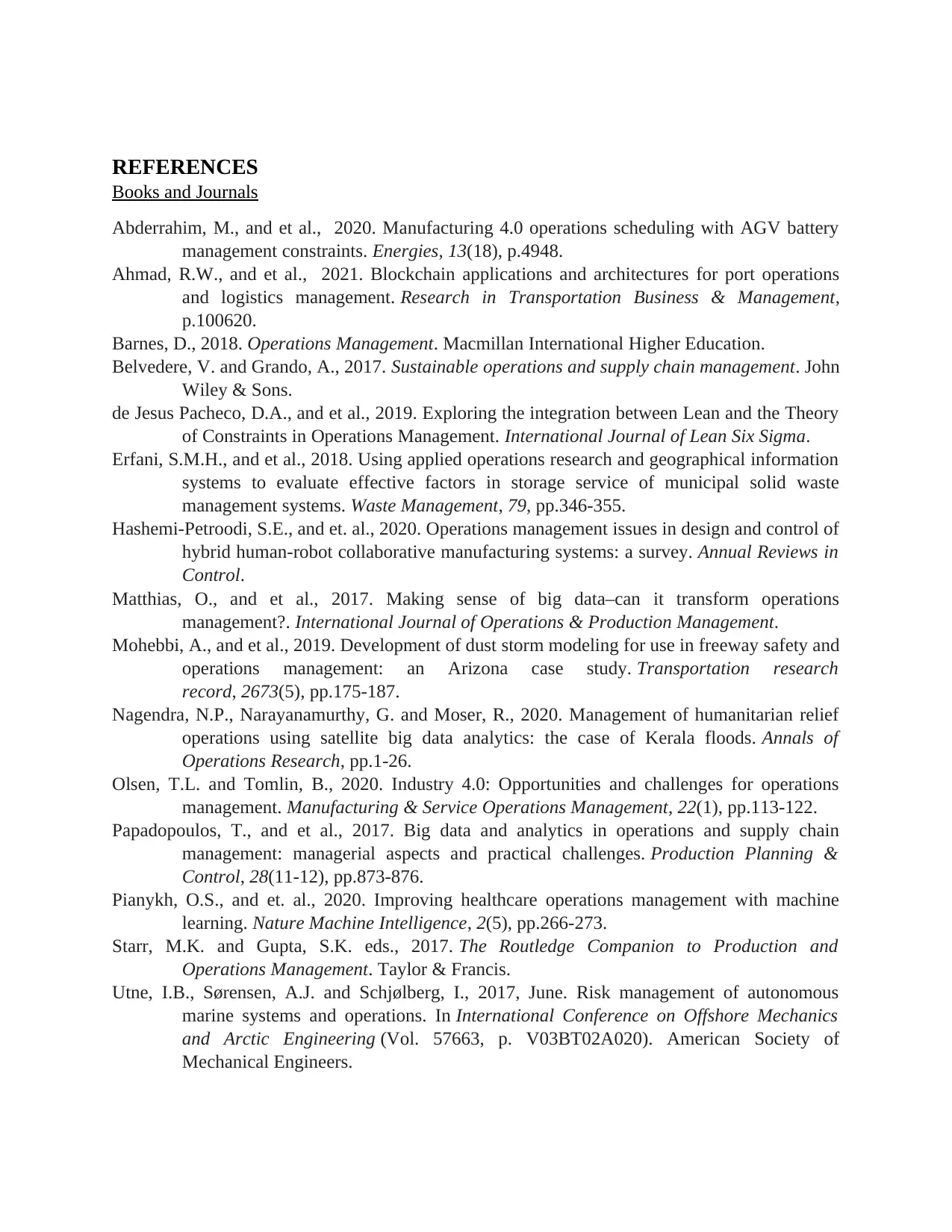
REFERENCES
Books and Journals
Abderrahim, M., and et al., 2020. Manufacturing 4.0 operations scheduling with AGV battery
management constraints. Energies, 13(18), p.4948.
Ahmad, R.W., and et al., 2021. Blockchain applications and architectures for port operations
and logistics management. Research in Transportation Business & Management,
p.100620.
Barnes, D., 2018. Operations Management. Macmillan International Higher Education.
Belvedere, V. and Grando, A., 2017. Sustainable operations and supply chain management. John
Wiley & Sons.
de Jesus Pacheco, D.A., and et al., 2019. Exploring the integration between Lean and the Theory
of Constraints in Operations Management. International Journal of Lean Six Sigma.
Erfani, S.M.H., and et al., 2018. Using applied operations research and geographical information
systems to evaluate effective factors in storage service of municipal solid waste
management systems. Waste Management, 79, pp.346-355.
Hashemi-Petroodi, S.E., and et. al., 2020. Operations management issues in design and control of
hybrid human-robot collaborative manufacturing systems: a survey. Annual Reviews in
Control.
Matthias, O., and et al., 2017. Making sense of big data–can it transform operations
management?. International Journal of Operations & Production Management.
Mohebbi, A., and et al., 2019. Development of dust storm modeling for use in freeway safety and
operations management: an Arizona case study. Transportation research
record, 2673(5), pp.175-187.
Nagendra, N.P., Narayanamurthy, G. and Moser, R., 2020. Management of humanitarian relief
operations using satellite big data analytics: the case of Kerala floods. Annals of
Operations Research, pp.1-26.
Olsen, T.L. and Tomlin, B., 2020. Industry 4.0: Opportunities and challenges for operations
management. Manufacturing & Service Operations Management, 22(1), pp.113-122.
Papadopoulos, T., and et al., 2017. Big data and analytics in operations and supply chain
management: managerial aspects and practical challenges. Production Planning &
Control, 28(11-12), pp.873-876.
Pianykh, O.S., and et. al., 2020. Improving healthcare operations management with machine
learning. Nature Machine Intelligence, 2(5), pp.266-273.
Starr, M.K. and Gupta, S.K. eds., 2017. The Routledge Companion to Production and
Operations Management. Taylor & Francis.
Utne, I.B., Sørensen, A.J. and Schjølberg, I., 2017, June. Risk management of autonomous
marine systems and operations. In International Conference on Offshore Mechanics
and Arctic Engineering (Vol. 57663, p. V03BT02A020). American Society of
Mechanical Engineers.
Books and Journals
Abderrahim, M., and et al., 2020. Manufacturing 4.0 operations scheduling with AGV battery
management constraints. Energies, 13(18), p.4948.
Ahmad, R.W., and et al., 2021. Blockchain applications and architectures for port operations
and logistics management. Research in Transportation Business & Management,
p.100620.
Barnes, D., 2018. Operations Management. Macmillan International Higher Education.
Belvedere, V. and Grando, A., 2017. Sustainable operations and supply chain management. John
Wiley & Sons.
de Jesus Pacheco, D.A., and et al., 2019. Exploring the integration between Lean and the Theory
of Constraints in Operations Management. International Journal of Lean Six Sigma.
Erfani, S.M.H., and et al., 2018. Using applied operations research and geographical information
systems to evaluate effective factors in storage service of municipal solid waste
management systems. Waste Management, 79, pp.346-355.
Hashemi-Petroodi, S.E., and et. al., 2020. Operations management issues in design and control of
hybrid human-robot collaborative manufacturing systems: a survey. Annual Reviews in
Control.
Matthias, O., and et al., 2017. Making sense of big data–can it transform operations
management?. International Journal of Operations & Production Management.
Mohebbi, A., and et al., 2019. Development of dust storm modeling for use in freeway safety and
operations management: an Arizona case study. Transportation research
record, 2673(5), pp.175-187.
Nagendra, N.P., Narayanamurthy, G. and Moser, R., 2020. Management of humanitarian relief
operations using satellite big data analytics: the case of Kerala floods. Annals of
Operations Research, pp.1-26.
Olsen, T.L. and Tomlin, B., 2020. Industry 4.0: Opportunities and challenges for operations
management. Manufacturing & Service Operations Management, 22(1), pp.113-122.
Papadopoulos, T., and et al., 2017. Big data and analytics in operations and supply chain
management: managerial aspects and practical challenges. Production Planning &
Control, 28(11-12), pp.873-876.
Pianykh, O.S., and et. al., 2020. Improving healthcare operations management with machine
learning. Nature Machine Intelligence, 2(5), pp.266-273.
Starr, M.K. and Gupta, S.K. eds., 2017. The Routledge Companion to Production and
Operations Management. Taylor & Francis.
Utne, I.B., Sørensen, A.J. and Schjølberg, I., 2017, June. Risk management of autonomous
marine systems and operations. In International Conference on Offshore Mechanics
and Arctic Engineering (Vol. 57663, p. V03BT02A020). American Society of
Mechanical Engineers.
⊘ This is a preview!⊘
Do you want full access?
Subscribe today to unlock all pages.

Trusted by 1+ million students worldwide
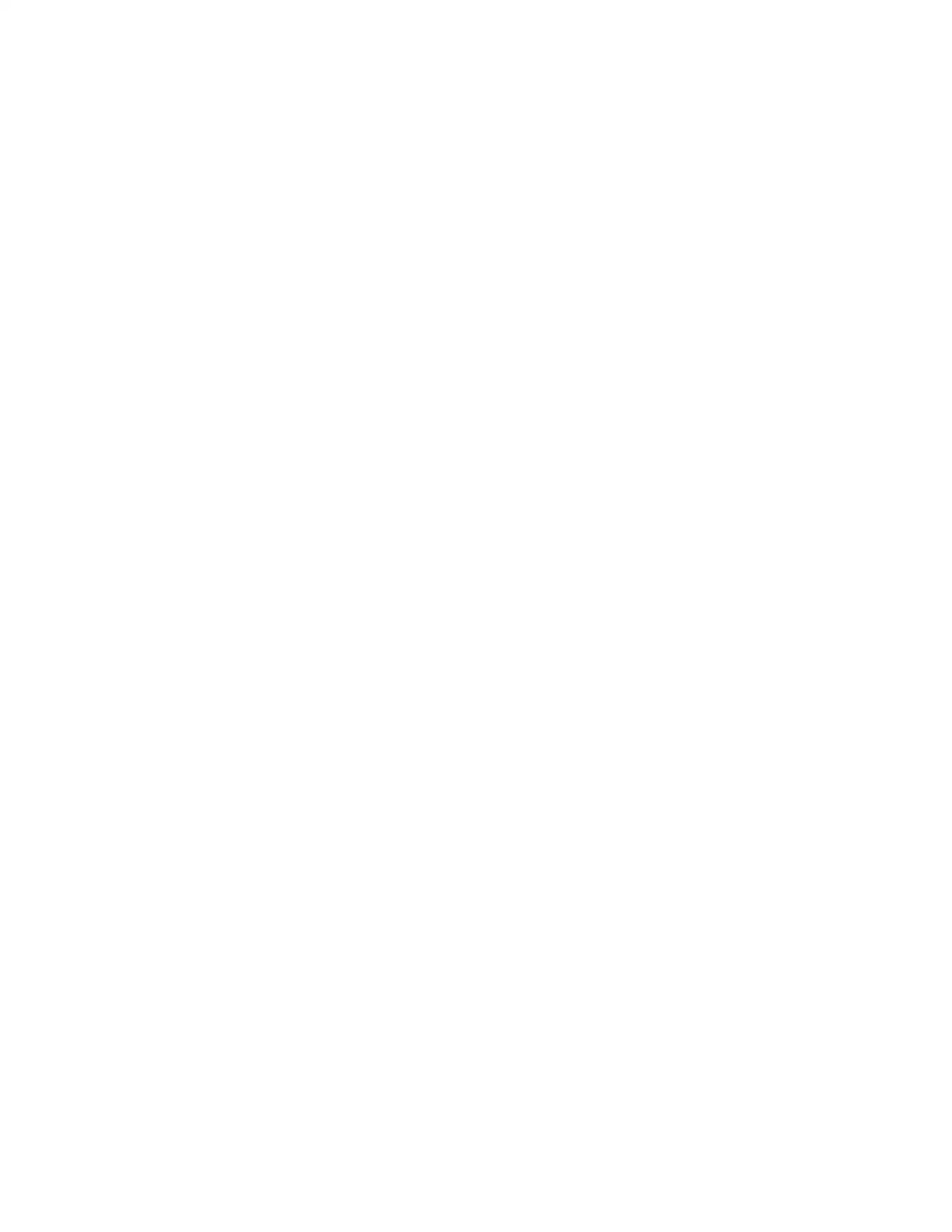
1 out of 10
Related Documents
Your All-in-One AI-Powered Toolkit for Academic Success.
+13062052269
info@desklib.com
Available 24*7 on WhatsApp / Email
![[object Object]](/_next/static/media/star-bottom.7253800d.svg)
Unlock your academic potential
Copyright © 2020–2025 A2Z Services. All Rights Reserved. Developed and managed by ZUCOL.





